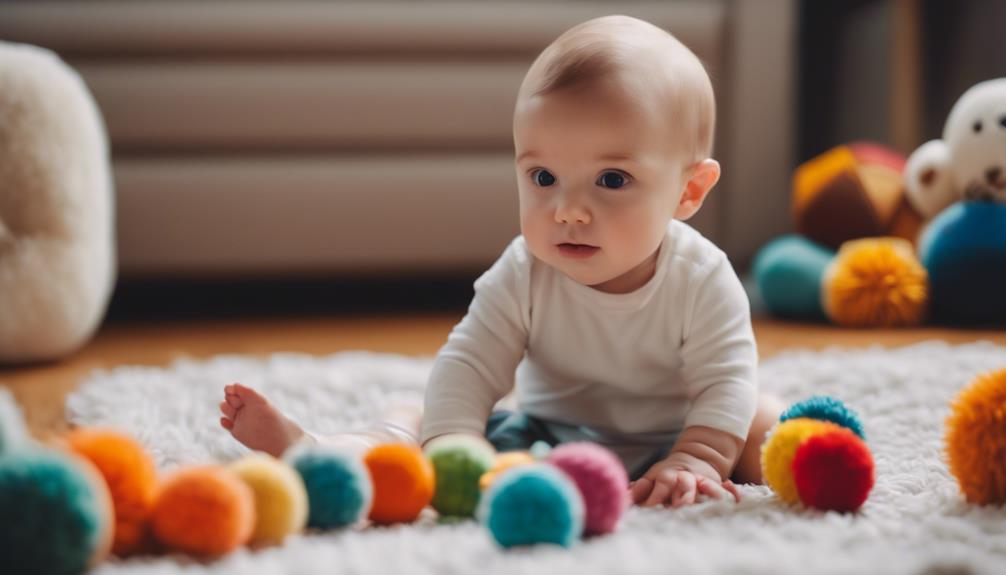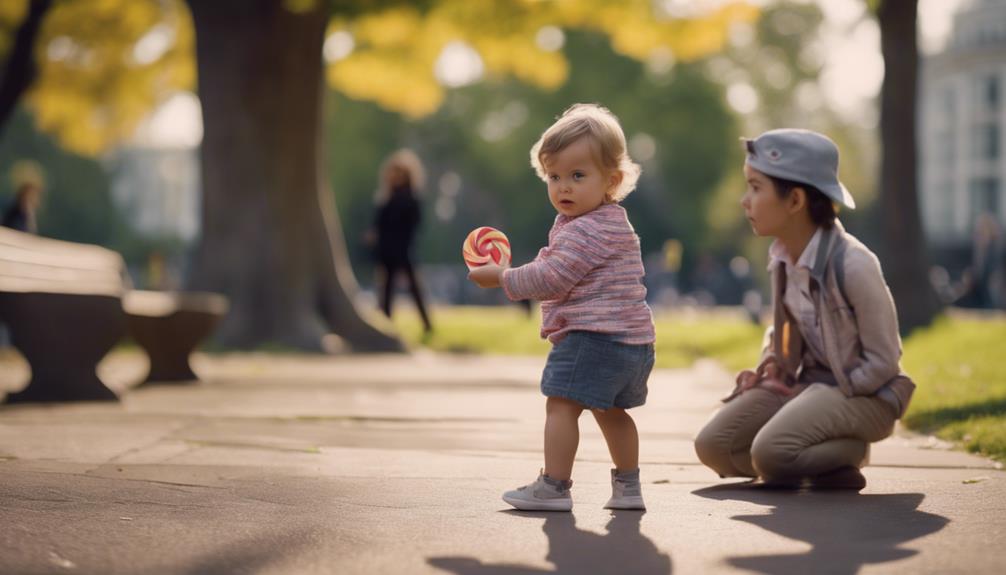Participate in imaginative play with baby dragons from Wings of Fire by decorating Dragon Eggs. Use paints, glitter, and stickers to transform the eggs. Make DIY Dragon Wings out of sturdy cardboard for pretend flights. Have a Dragon Themed Scavenger Hunt to hide baby dragon eggs. Create dragon puppets to bring stories to life. Throw a Dragon Dance Party for an active and enjoyable time. Promote adventure with a Dragon Treasure Hunt. Spark creativity with Dragon-Themed Coloring. Dive into a fantasy world with these creative play suggestions.
Key Takeaways
- Create a dragon egg decorating activity for immersive play.
- Design DIY dragon wings for imaginative role-playing.
- Craft dragon puppets for interactive storytelling adventures.
- Organize a dragon-themed scavenger hunt for active play.
- Utilize dragon coloring pages for creative expression and storytelling.
Dragon Egg Decorating Activity
Get ready to awaken your creativity with the Dragon Egg Decorating Activity! Children will have a blast transforming plastic or foam eggs into mystical dragon eggs using an array of decorating materials. From vibrant paints to sparkling glitter, stickers, and markers, the possibilities are endless for designing unique and colorful dragon eggs. Encourage the young dragon enthusiasts to let their imagination run wild as they craft these magical creations.
Once the dragon eggs are adorned with creativity, display them in a nest or basket for an enchanting touch. This not only showcases the children's handiwork but also adds a whimsical element to the imaginative play experience.
The Dragon Egg Decorating Activity fosters the development of creativity, fine motor skills, and imaginative play among the participants, making it a delightful and educational craft for young minds to explore.
DIY Dragon Wings Craft

Craft your own DIY dragon wings using cardboard, paint, and elastic straps to enhance imaginative play experiences. Cut out wing shapes from the cardboard and paint them in vibrant colors to mimic dragon wings. Attach elastic straps to the wings so children can wear them comfortably. Encourage kids to pretend to fly and act like baby dragons with their homemade wings. This craft promotes creativity, imaginative play, and fine motor skills development in children.
Creating dragon wings is a fun and engaging activity that allows children to immerse themselves in the world of mythical creatures. By following these steps, kids can craft their very own dragon wings and let their imaginations soar:
- Cut out wing shapes from sturdy cardboard material.
- Paint the wings in bright and bold colors to give them a magical and dragon-like appearance.
- Securely attach elastic straps to the wings to provide a comfortable fit for little ones.
Encourage children to flap their wings and engage in imaginative play scenarios. Watch as kids embrace their inner dragons and enjoy hours of creative fun with their homemade wings.
Dragon Themed Scavenger Hunt
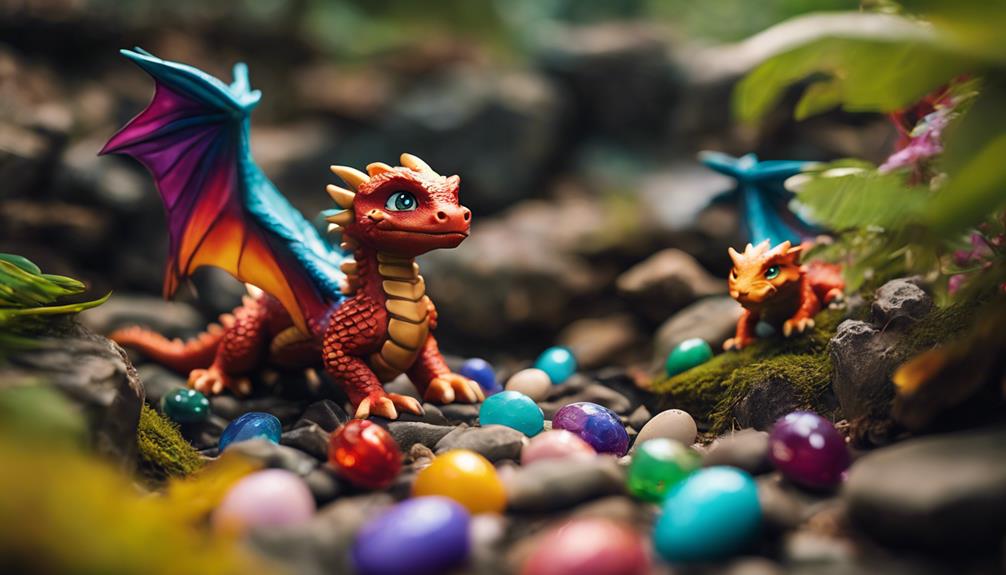
Transform your play area into a magical world with a Dragon Themed Scavenger Hunt that will ignite excitement and adventure in young imaginations.
Set up a thrilling quest by hiding baby dragon eggs in various nooks and crannies. Craft clues that will lead the children on an exhilarating journey to discover these mystical treasures.
Whether under cushions, behind books, or in toy chests, make sure the hiding spots are cleverly chosen to keep the little ones engaged.
To enhance the experience, include interactive challenges or tasks at each egg location. These activities won't only add an element of fun but also encourage teamwork and problem-solving skills.
Once the kids have successfully found all the baby dragon eggs, reward their efforts with small dragon-themed prizes or treats.
This Dragon Themed Scavenger Hunt is a fantastic way to stimulate creativity, promote physical activity, and provide hours of imaginative play for young dragon enthusiasts.
Dragon Storytelling Circle
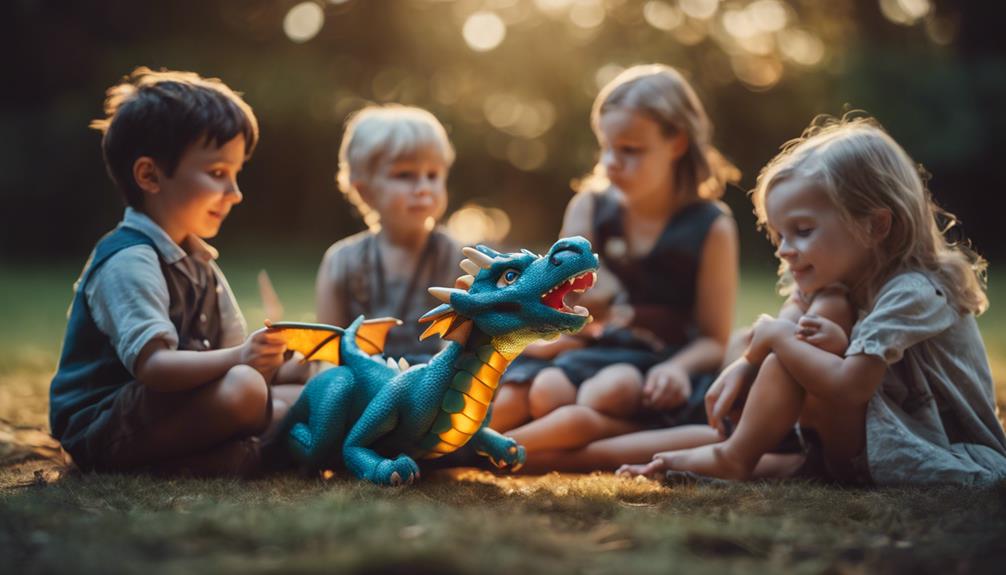
To continue the imaginative play adventure, set up a Dragon Storytelling Circle with cozy blankets and pillows for engaging storytelling sessions.
Immerse yourself in the enchanting world of dragons from the Wings of Fire series through interactive storytelling. Fuel creativity and excitement by incorporating the following elements:
- Utilize dragon puppets or plush toys to bring scenes from the book series to life.
- Encourage children to share their own dragon stories or adventures, fostering their storytelling skills.
- Enhance the experience with props like dragon eggs or scales, immersing participants in the dragon-themed narrative.
- Create an enchanting atmosphere by using a dragon-themed backdrop or shadow puppet theater for interactive storytelling sessions.
- Embrace the magic of storytelling by taking turns sharing tales of bravery, friendship, and adventure inspired by the Wings of Fire series.
Gather around the Dragon Storytelling Circle and enter a world filled with imagination and wonder.
Dragon Dance Party

Get ready to spark the dance floor with an epic Dragon Costume Contest where kids can showcase their creativity and imagination.
Follow it up with a thrilling round of Musical Dragon Statues, where little ones freeze in their dragon poses when the music stops.
Finally, ignite the fiery energy with a competitive Fiery Dance Battle, where children can show off their best dragon dance moves.
Let the dragon dance party begin!
Dragon Costume Contest
Encourage children to participate in a lively dragon costume contest where they can showcase their imaginative baby dragon outfits and dance moves at the Dragon Dance Party.
To make the contest enjoyable and engaging, consider the following:
- Provide various dragon-themed accessories like wings, tails, and scales for the contest.
- Include judging criteria such as creativity, originality, and dragon-like movements to determine the winners.
- Organize a dance party where kids can't only display their dragon costumes but also dance like baby dragons.
- Award prizes or certificates to the winners of the dragon costume contest to add excitement and motivation for all participants.
- Embrace the spirit of creativity and fun inspired by the Wings of Fire book series to encourage children to express themselves through their unique dragon costumes and dance performances.
Musical Dragon Statues
For an engaging and interactive experience at the Dragon Dance Party, set up a musical dragon statues game where children can dance like dragons to the rhythm of the music. Play dragon-themed music to inspire the kids to move like baby dragons, incorporating their wings and tails into the dance. Encourage the children to freeze when the music stops, mimicking the stillness of a dragon statue. To enhance the imaginative play experience, provide dragon costumes or props, allowing the children to fully immerse themselves in the world of dragons.
Incorporating dragon-themed decorations and props will help create an immersive dragon dance party atmosphere. The use of dragon banners, cave-like settings, and fiery colors can transport the children into a mythical dragon domain, fostering creativity and excitement. This activity not only promotes physical activity but also encourages social interaction among the children as they dance and play together in the magical world of dragons.
Fiery Dance Battle
To elevate the energy and excitement at the Dragon Dance Party, ignite a fiery dance battle featuring baby dragon plush toys for a dynamic and engaging playtime.
Create a dragon dance party atmosphere with music, lights, and dragon-themed decorations. Encourage children to make their baby dragons 'dance' to the music in a friendly competition. Use colorful scarves or ribbons as props for the baby dragons to enhance the dance battle.
Let the children's creativity shine as they choreograph and perform their dragon dance routines with their baby dragons.
Dragon Tail Tag Game
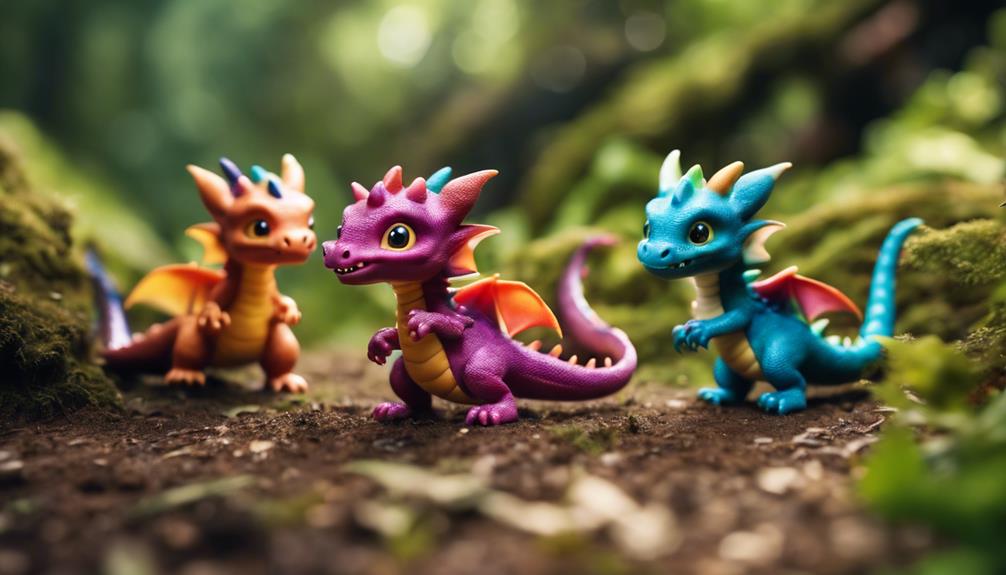
In the game of Dragon Tail Tag, players simulate baby dragons chasing each other to grab their colorful tails. Each player can use vibrant scarves or ribbons tucked into their waistbands as their dragon tails. The main objective is for the dragons to chase and capture each other's tails without losing their own.
When a dragon successfully snatches another's tail, the caught player can either sit out or team up with the dragon who caught them to chase others.
Dragon Tail Tag isn't just about fun; it also promotes physical activity, coordination, and social interaction among children participating together. This game encourages children to move around actively, strategize to catch tails while protecting their own, and engage in friendly competition.
Dragon Treasure Hunt
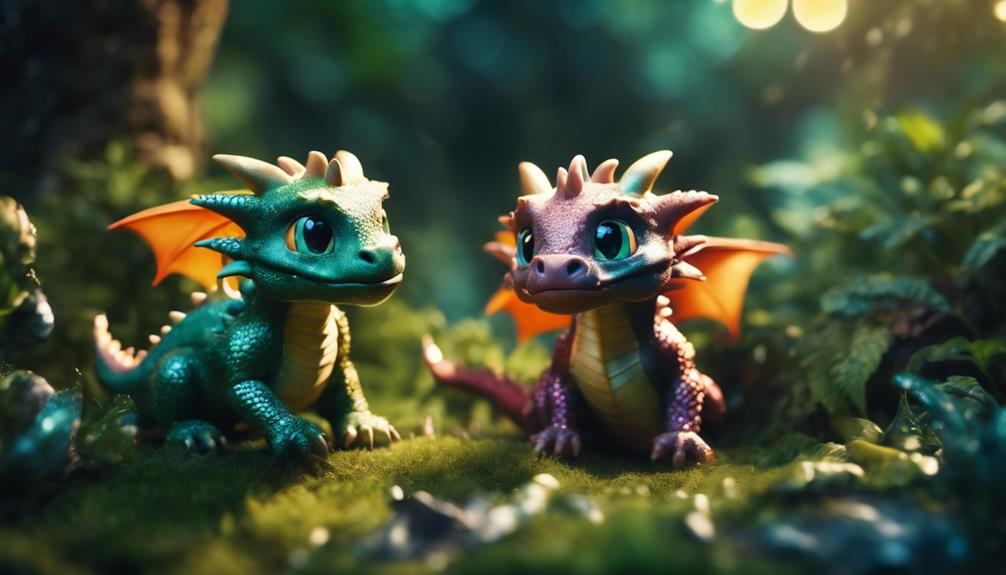
Shifting from the exhilarating game of Dragon Tail Tag, challenge the children with a thrilling Dragon Treasure Hunt. Create a sense of adventure by hiding dragon-themed items or clues around the play area. Use a map or simple instructions to guide the children to different treasure locations, fostering their problem-solving skills.
Encourage imaginative play as they set out on a quest to find hidden dragon treasures, sparking creativity and exploration. At each treasure location, include challenges or puzzles to enhance the fun and engagement, making the hunt even more exciting.
Once the children complete the dragon treasure hunt, reward them with small dragon-themed prizes or treats, celebrating their accomplishment and adding to the joy of the game. This activity not only entertains but also promotes teamwork, critical thinking, and imaginative play in a dynamic and enjoyable way.
Dragon Puppet Theater
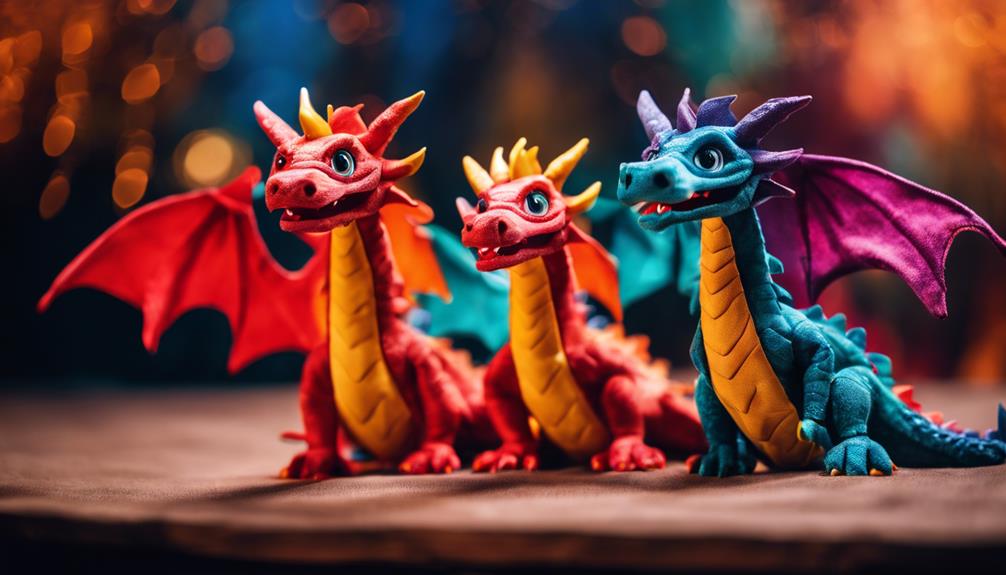
Craft your own dragon puppets using simple materials like paper bags, felt, and googly eyes to bring these mythical creatures to life.
Construct a puppet theater using a cardboard box or fabric draped over a table, providing a stage for your dragon adventures.
Engage in imaginative play and storytelling as you act out scenes from popular dragon tales or create your own magical stories with the baby dragon puppets.
Puppet Making Tips
Using colorful felt or fabric, create dragon puppet bodies and wings for an engaging puppet theater experience. To make your dragon puppets truly captivating, consider the following puppet making tips:
- Add intricate details like buttons for eyes, felt flames for breath, and yarn for tails to bring your baby dragon puppets to life.
- Attach puppet sticks or strings to allow for seamless movement and fluidity during puppet theater plays.
- Utilize different textures and materials to enhance the sensory experience and make the puppets more interactive.
- Encourage imaginative storytelling and role-playing by involving children in the puppet making process, letting them personalize their dragon puppets.
- Create a mini puppet theater stage using a shoebox or cardboard to set the scene for interactive plays and spark creativity in young minds.
Theater Storytelling Ideas
To further engage children in imaginative play with their baby dragon puppets, consider setting up a dragon puppet theater for interactive storytelling experiences. Transform a designated area into a magical stage where the baby dragons come to life through the hands of the young storytellers. Use distinct voices and movements for each baby dragon puppet to enrich the storytelling journey. Encourage children to let their creativity soar by crafting unique dragon-themed tales and acting them out on the puppet theater. Enhance the experience by incorporating props and scenery that complement the fantastical world of the baby dragons.
Through puppet theater activities, children not only immerse themselves in imaginative play but also develop essential skills. The interactive nature of puppet storytelling promotes language development as children articulate their narratives. Additionally, engaging in collaborative storytelling with peers fosters social skills as they work together to bring their dragon tales to fruition.
Dragon Coloring Pages and Activities
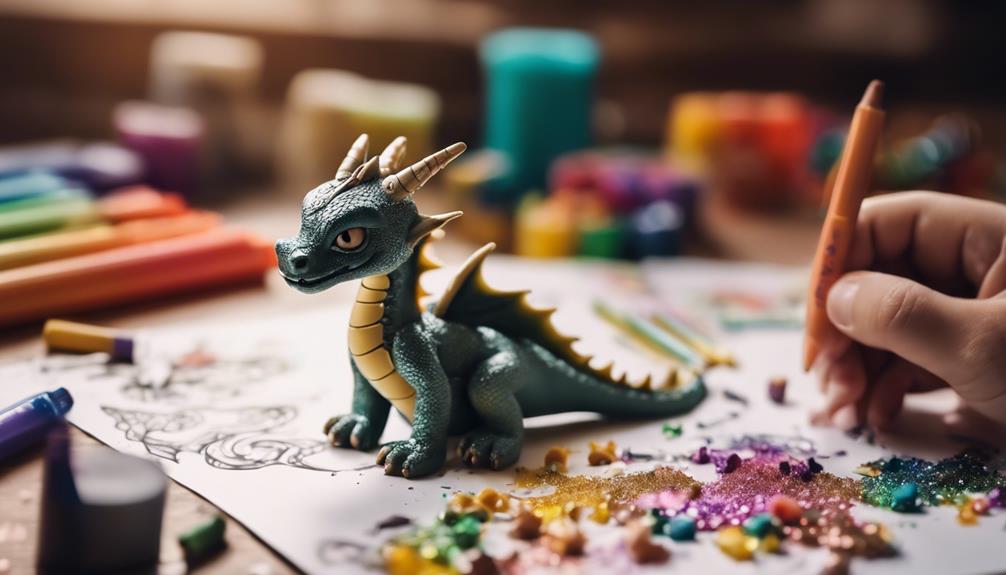
Engage children in imaginative play and creativity with dragon coloring pages and activities that spark interest and excitement in young learners.
Coloring pages featuring dragon silhouettes can be a delightful way to introduce children to the world of mythical creatures. Not only do these activities provide entertainment, but they also offer various developmental benefits for the young minds engaging in them.
Here are some key points to keep in mind:
- Dragon coloring pages can enhance imaginative play and creativity.
- Coloring activities help in the development of fine motor skills and hand-eye coordination.
- Printable pages with baby dragon designs ignite curiosity and joy in children.
- Coloring can serve as a calming and relaxing pastime for kids to enjoy.
- Encouraging children to color dragon-themed pages can inspire storytelling and creative expression.
Encourage your little ones to pick up their favorite crayons and bring these enchanting baby dragons to life through vibrant colors and imaginative stories.
Frequently Asked Questions
What Is the Rarest Tribe in Wings of Fire?
The rarest tribe in Wings of Fire is the NightWings. With their unique abilities and prophetic powers tied to the moon, they stand out. Dark scales, silver underscales, and color-changing teardrop scales signify their rarity.
What Is the Most Powerful Dragon in Wings of Fire?
In Wings of Fire, the most powerful dragon is Thorn, the SandWing queen. She's known for her strength, leadership, and possession of the Eye of Onyx. Her influence and strategic abilities solidify her reputation as the top dragon.
How to Make a Good Wings of Fire Story?
To make a good Wings of Fire story, create unique dragon characters with diverse backgrounds and abilities. Weave themes of friendship, adventure, and conflict into a compelling narrative. Utilize the series' rich lore and world-building for depth.
Who Is the Oldest Dragon in Wings of Fire?
The oldest dragon in the Wings of Fire series is Darkstalker, an animus NightWing-IceWing hybrid who lived thousands of years ago. He possessed powerful magic and his actions had a lasting impact on Pyrrhia's history.
Conclusion
Let your imagination take flight with these wings of fire baby dragon play ideas.
From decorating dragon eggs to crafting dragon wings, there are endless ways to engage in imaginative play with these mythical creatures.
So gather your little ones and set off on a journey filled with adventure, creativity, and fun.
Ignite the magic of dragons and watch as your little ones soar into a world of make-believe like never before.
Let the wings of fire baby dragons spark their imagination!



